Wearing the right kind of shoes actually can help reduce the risk of falling, so choosing the right footwear should be a key element in your fall-prevention plan. Footwear to avoid includes shoes with high heels, any shoes with slick soles and floppy slippers. Backless shoes come with an increased risk of falling, too, as does walking around in your stocking feet or wearing shoes with laces untied. So, how to you pick shoes to help prevent falls? Read on for tips.
Properly Fitting Shoes
This may sound obvious, but poorly fitting shoes make it more likely that you’ll fall. Your shoes should fit snugly (but not too tightly), which means that footwear with laces and Velcro are good choices since you can adjust them to fit your feet. Slippers, slip-on shoes and flip-flops are less form-fitting and, therefore, less safe. If your shoes don’t fit well, it may alter the way you’re walking, and that also can be hazardous. And although it’s tempting to hold onto shoes that are old favorites, shoes that have become stretched are, by definition, no longer properly fitting, so stop wearing them.
Sturdy Shoes
PreventFalls.ca recommends that you “wear footwear that has a lot of contact with the ground, such as shoes with a flat or low, wide heel.” So, besides avoiding high heels, also avoid shoes with narrow heels. When selecting a shoe, press on both sides of the heel area, suggests APMA.org, to ensure that the heel is “stiff and won’t collapse.” While you’re at it, make sure the toe area is flexible. It “shouldn’t bend too much . . . but it shouldn’t be too stiff and inflexible either.” Try twisting the shoe to make sure it doesn’t twist in the middle.
Shoes with Nonskid Soles
Soles should have a quality grip, and you should wear them inside your house, as well, rather than simply wearing socks or slippers.
Professionally Measured Shoes
Yes, you should get your feet professionally measured each time you buy shoes because the size of your feet can change with aging or with changes in your health. Both feet should be measured, ideally later in the day, and you should purchase shoes that most closely fit the larger foot. When you are being fitted, wear or bring with you the type of socks or hose you’ll typically wear with those shoes.
Comfortable Shoes
When you find a pair of shoes you like, it’s easy to convince yourself that, even though they don’t fit perfectly yet, you can break them in. Resist the temptation! If shoes don’t feel comfortable in the store, don’t purchase them.
Specialty Shoes, When Needed
You may have health issues or foot issues that require special shoes. If so, talk to your podiatrist about what to wear and follow the recommendations. If you are prescribed orthotics that need to be inserted into your shoes, take them with you whenever you go shoe shopping. Quality shoes that promote good foot health get the APMA Seal of Acceptance, so watch for that designation.










